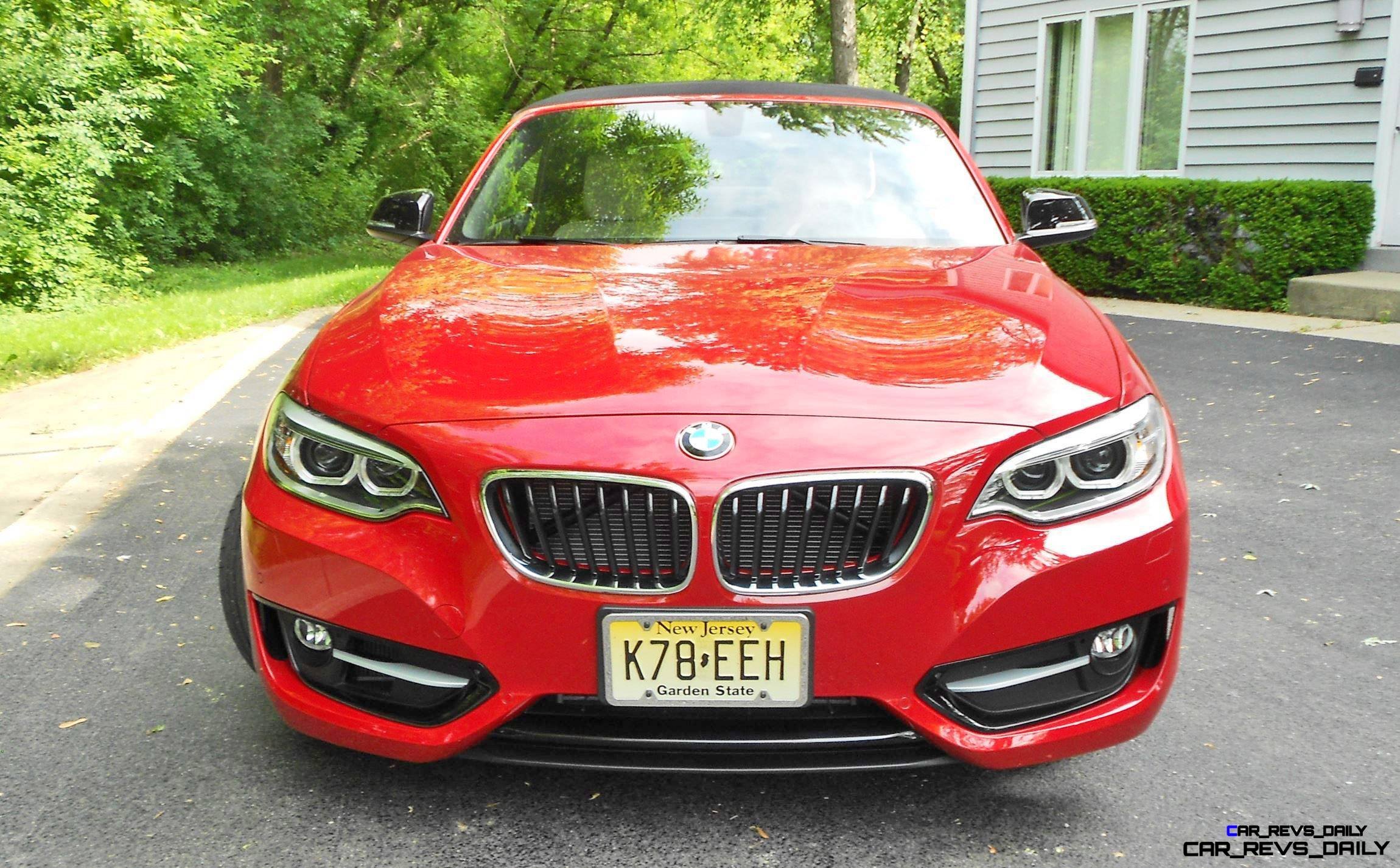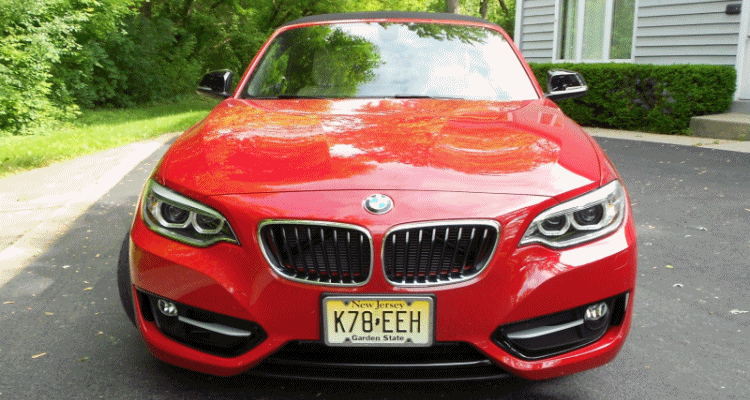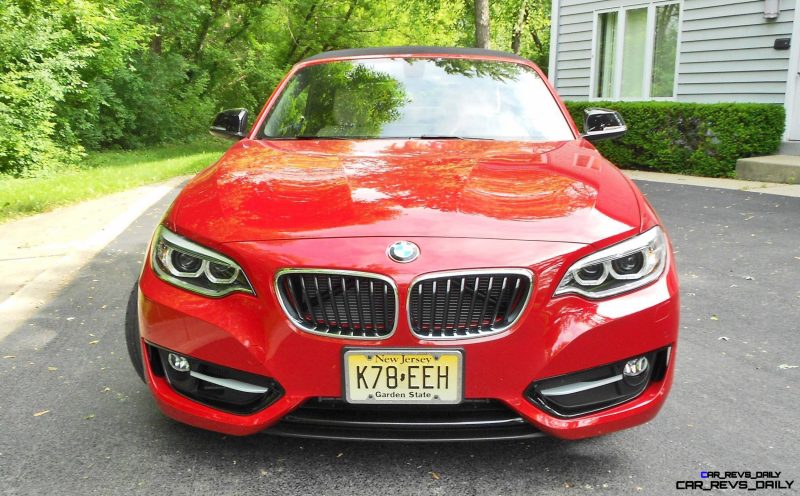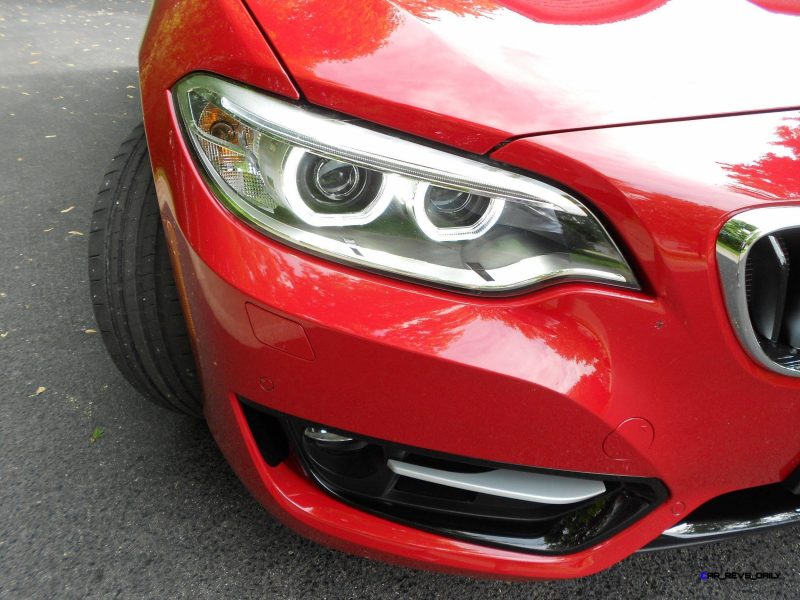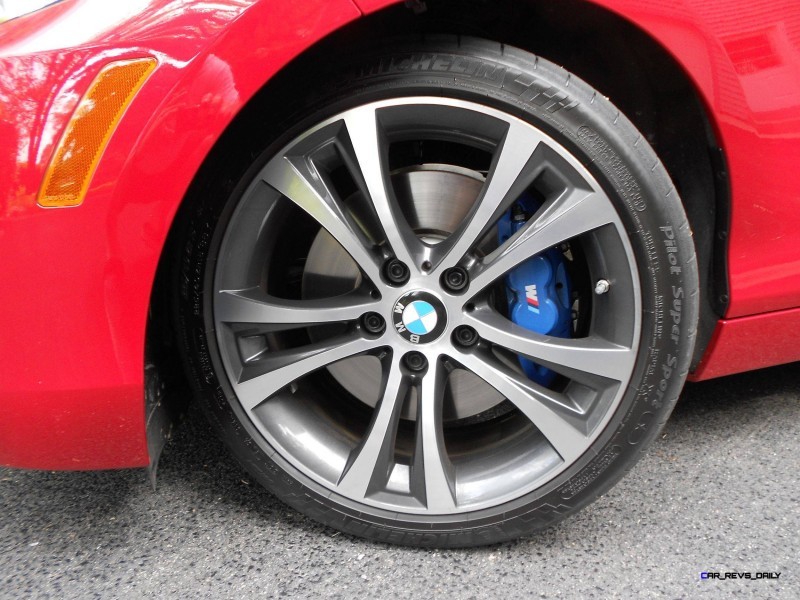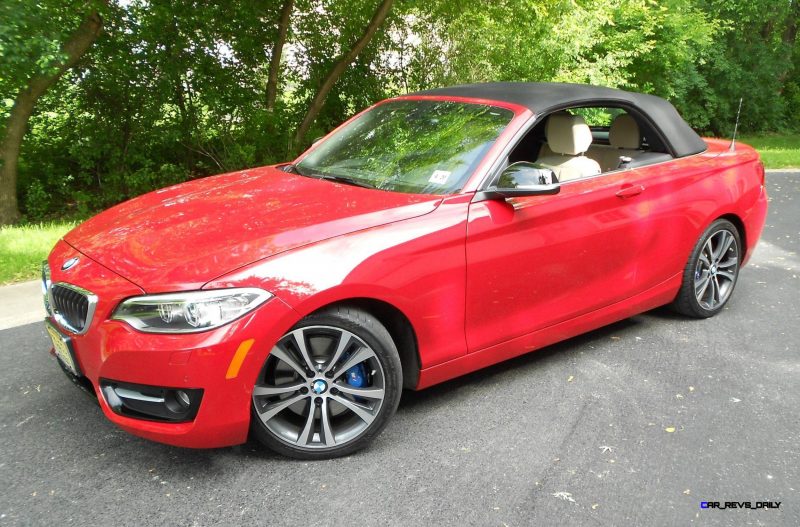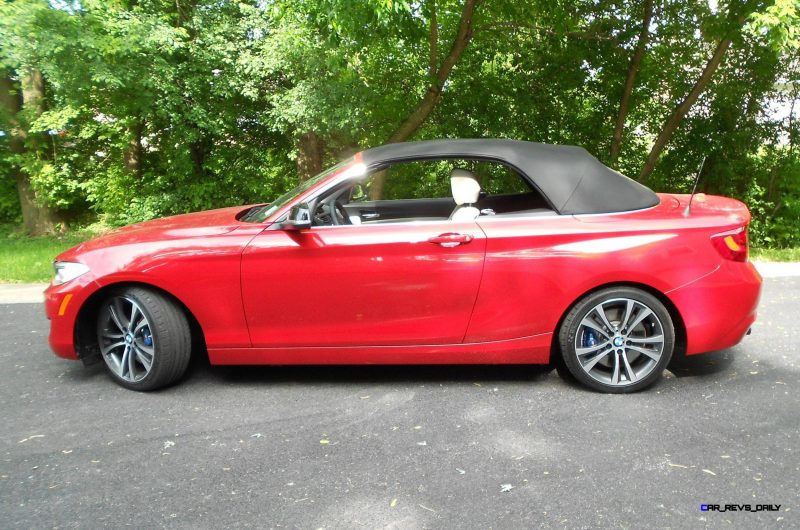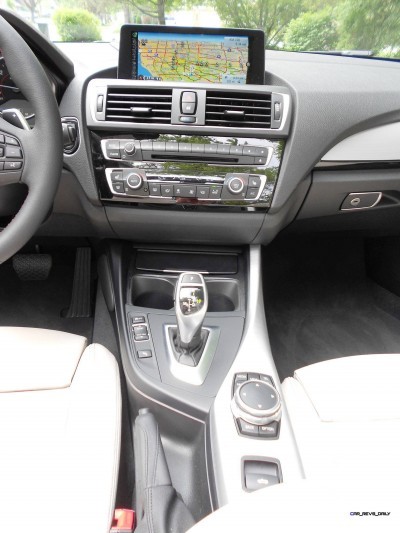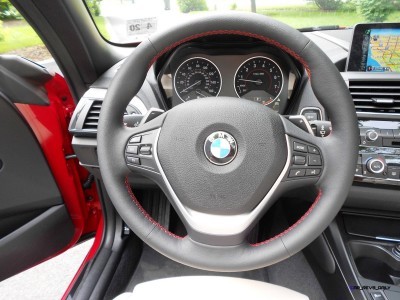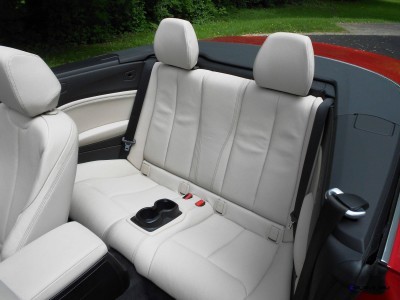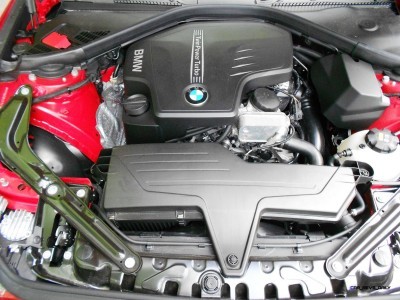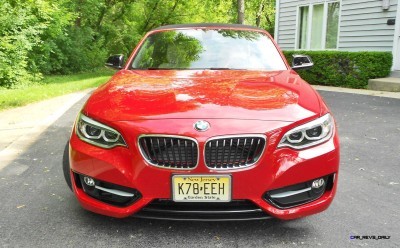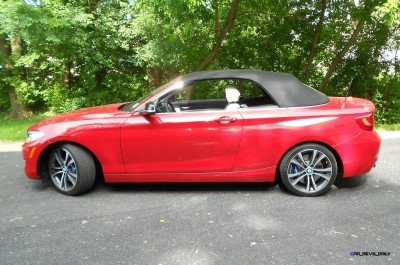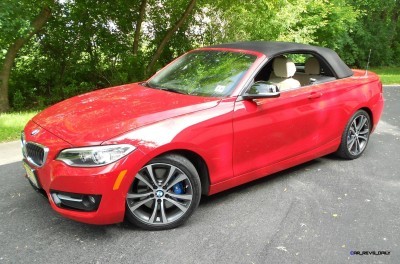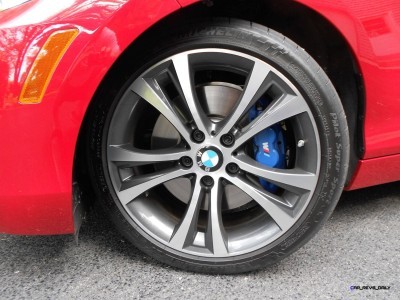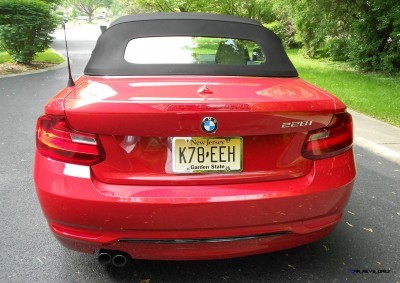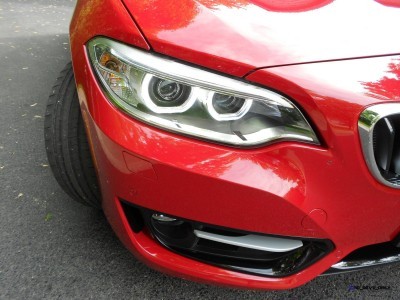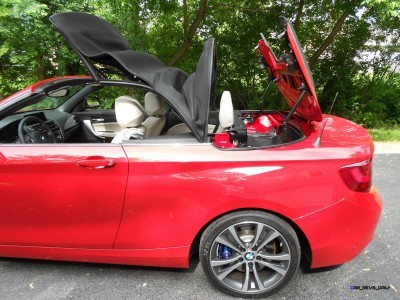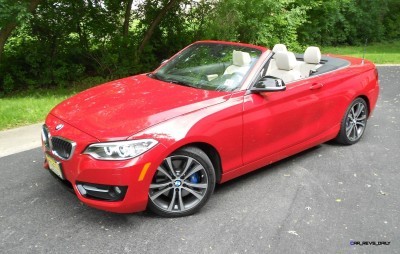2015 BMW 228i Convertible Review
By Ken Glassman
The 2015 BMW 228i convertible replaces the 1-Series as the company’s entry level rag top. This version has a 1.2-inch-longer wheelbase, has 2.5 inches of additional length, and extra inch of width. And that helps to make it less stubby looking than the 1-Series cars. The better proportions, along with sharp character lines along the sides, and sleek front end, means that this 2-Series is a great looking car. It is also a really fun car to drive.
The 228i is powered by a 2-liter, TwinPower Turbo inline 4, direct fuel injected engine that makes a respectable 240hp at @5,000 rpm. But the 255 ft. lbs. of torque comes in at a low 1450 rpm, so the engine feels sharp off the line. BMW claims zero to 60 in 5.7 seconds with 130mph terminal velocity. And the claimed gas mileage is 23 City and 34 Highway while filling up the 13.7 gallon gas tank with premium fuel. Helping gas mileage is the engine shut down at stop lights. However, the restarts of the engine are a bit rough, and sometimes a bit hesitant when taking off.

The 228i does not offer a manual transmission, but the 8-speed Steptronic transmission is excellent, with sporty tuning in fully automatic mode, and good, quick response when you feel the need to paddle shift the gears yourself. Despite the porky curb weight of 3,625 lbs., the engine is more than up to the challenge to quickly accelerate and pass slower moving traffic when needed.
The brakes are excellent, with good stopping power and excellent pedal feel. Same good thoughts about the steering. Quick and responsive, with good feel. By selecting the Sport mode, over Normal and Eco settings, you get a little bit heavier steering feel, and shift points are reached higher in the rev range.
The test car was equipped with the $2,050 Sport Line trim package which adds 18-inch wheels, with Michelin Pilot Super Sport tires, a sport suspension, and a few cosmetic items. It also had the Track Handling Package, for $1,600, which adds adaptive M suspension (with lower ride height and adaptive shocks), the M Sport braking system (larger discs clamped down on by four-piston calipers in front, two-piston fixed calipers in the rear), and variable sport steering.


All of that means the ride quality on smooth highway roads is very comfortable, and never harsh. There is almost no discernable cowl shake when the top is down, unlike the $275,000 Aston Martin convertible I recently drove. And when you feel like tossing the car around the twisties, there is little body lean, and it makes for an entertaining and exhilarating ride as you can find. It feels taut, athletic as a middle linebacker, and rock solid. It is hard to match the fun factor and exhilaration that you get with this car. But that is where my affection and admiration for the 228i ends.
The interior design and appointments are good, but nothing exceptional and certainly nothing that says you’re in a very expensive luxury car. What should be soft touch materials on the tops of the door sills and other places, are not so soft. The area surrounding the shift leaver is looks cheap and plasticky. The large door pockets are chopped up into 4 sections, making it hard to use for larger items, and they have rough edges. The door pulls are placed too far forward to make closing the wide opening doors more difficult. The window lock button is oddly located up on the dash, instead of on the door panel with the rest of the switches. The remnant of an ash tray at base of the center stack with a door is useless for anything except paperclips and small amount of loose change.
There is no LED info screen between the tach and speedometer for the little things like current and average fuel economy and distance to empty, and other readings normally found there. Instead you have to use the dreaded iDrive knob to navigate around the system and view that on the large screen on top of the center stack. And if you’re using the Navigation system, and want to get radio or mileage info, you must leave the map, to do it. iDrive makes entering addresses into the Nav system cumbersome, and voice recognition is an exercise in futility.
The sport seats offer a nice lower thigh pull out, which is nice, but the seats are too narrow and you’ll find yourself squirming around in them on long trips. And I’ve never been a fan of BMW leather, at least in their less expensive cars. They have a texture like the pigskin on a football, and feel stiff, unlike the leather found on most American and Japanese cars. And despite the fact that the car only had a few thousand miles and I’m pretty sure not many rear seat passengers, the leather on the seatbacks was sagging. Adults will not be able to use the back seats because of leg room, and the seat backs are bolt upright which becomes uncomfortable after only a few minutes. They do, however, fold down and add room to the already decent trunk size, due to the fact that the soft top has its own storage area separate from the rest of the trunk.
The wind deflector to calm the noise and airflow in the cabin is cumbersome and not easily operated, and I found that while driving on the highway with the top down, the airflow makes the seatbelt pound the drivers left shoulder and becomes annoying after an hour or so. That may have something to do with the drivers height and seat settings, but I can’t understand why all convertibles haven’t copied Chryslers lead from years ago, and place the seatbelt in the upper part of each seat, so that buffeting can’t happen, and also leaves an unobstructed entry into the rear.
But my biggest disappointment with this car is that fact that with a base price of $37,900, why should a customer have to spend $3,650 on handling option packages to get the driving excitement that BMW is known for? Isn’t that part of the “Ultimate Driving Machine?” And with a total of $12,800 in options, bringing the bottom line up to $51,650, why is there no Blind Spot or Lane Departure warning systems, which are the best anti-accident safety features since ABS brakes? Those features are found as standard on cars costing $20,000 less.
The $24,000 Hyundai Veloster I had last week, had the back-up camera as standard, while it’s a $950 option (along with Park Distance Control) on the BMW. Heated seats? That’s part of the Cold Weather Package for $700 – and no cooled seats – for a luxury convertible! Maybe there’s a Warm Weather Package I’m not aware of. The tilt and telescope steering wheel are manual, not electric, and the memory seat doesn’t have a setting to move back when the car shuts off. Shouldn’t a luxury manufacturer include some luxury in their car?
I understand that with Chrysler no longer making a moderate priced convertible and Volkswagen doing away with their Eos Convertible, there are few open-air cars to choose from. Except for the Mazda Miata, the rest of the drop tops are in the upper end of the price spectrum, so the makers are forcing fans of drop top driving to pony up. But it seems like there should be more content built in, and not gouge customers to have to make their luxury cars luxurious. At $51,650 there’s not value there. Look to the Audi A3 Cabrio to get more bang for the buck.
By Ken Glassman
Read Ken’s other drive reviews over here!

Ken “Hawkeye” Glassman has been a motor journalist for over 30 years, reviewing automobile, as well as motorcycle ride reviews and accessory reviews.
His car articles have appeared in Robb Report Magazine, Autoguide.com, Car-Revs-Daily.com and other media. His work has also appeared in Road Bike Magazine, Motorcycle Tour and Cruiser, SpeedTV.com, MotorcycleUSA.com and others.
As motorcycle columnist for The Daily Herald in suburban Chicago, the paper became the only major circulation newspaper in the country to have a separate weekly section devoted to motorcycles. Later he wrote a weekly column for Cyclefocus Magazine.

